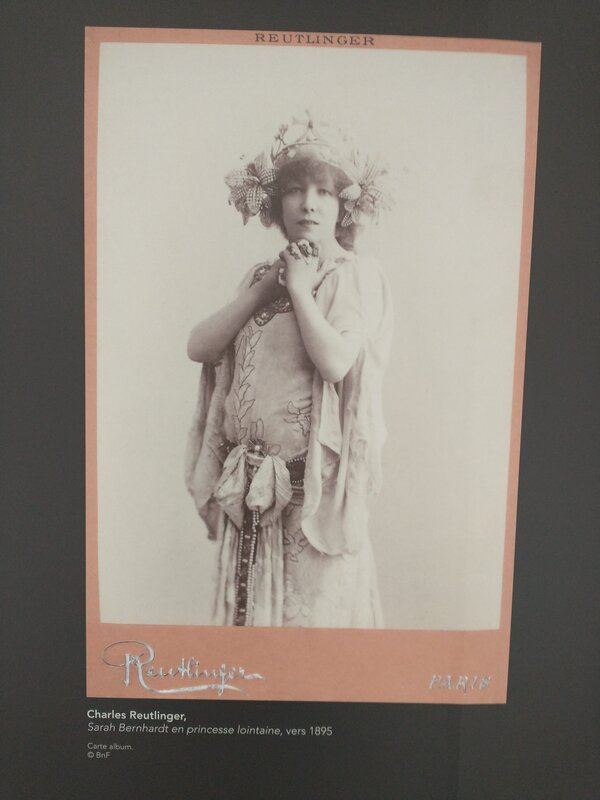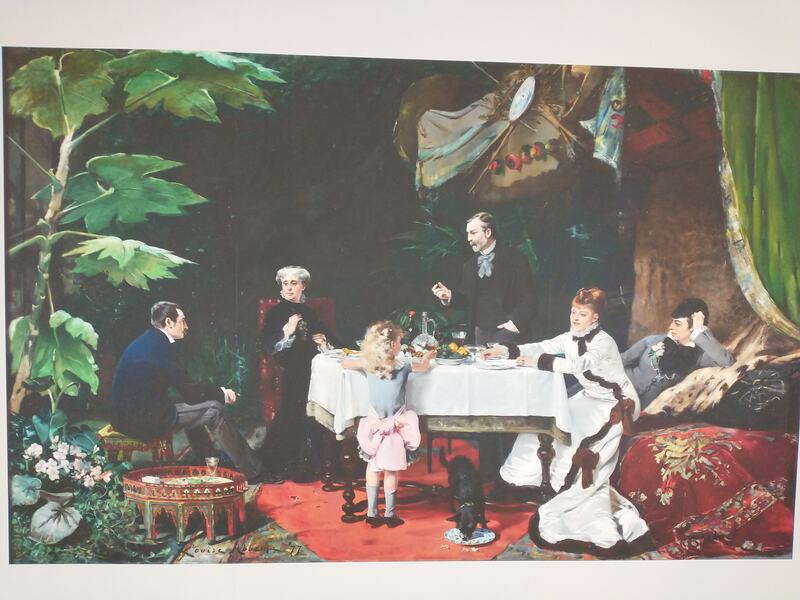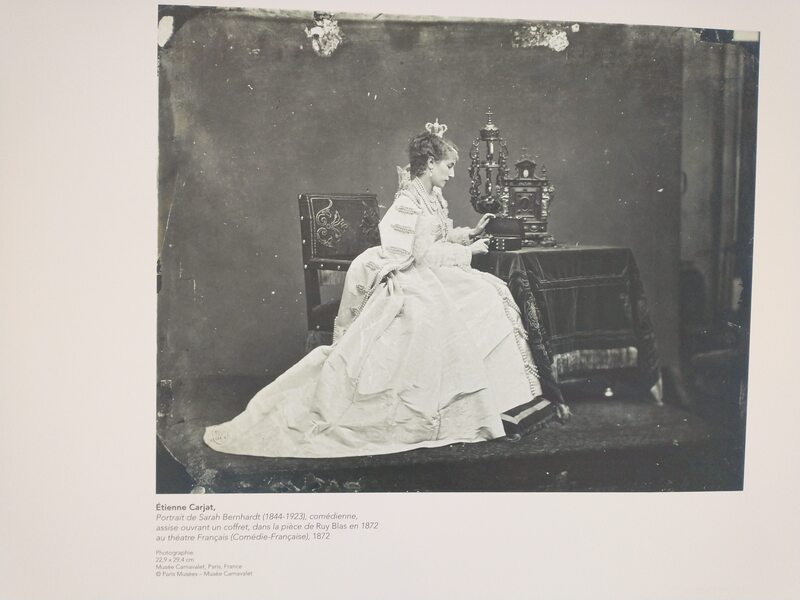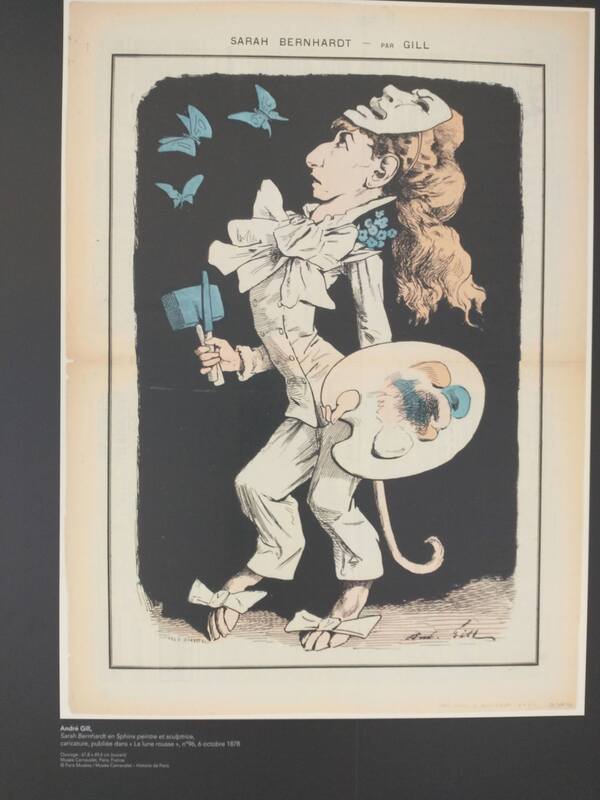|
Today was our leaving day and frankly I was very glad to be leaving Paris. Sarah Bernhardt ExhibitionSarah Bernhardt was a French actress famous in the late 19th and early 20th centuries. I don't know why the train station had an exhibition on Sarah Bernhardt. Maybe they put it up for her 100th Death Day anniversary in March and just left it up. I don't read French, so I couldn't tell you. I did take photos of all the text that was in the exhibit, so if any of you actually read French, I'd love to know what it all says, especially the quotes. If you don't know anything about Sarah Bernhardt, I've included some highlights of her "stranger than fiction" life/career courtesy of my extensive research on Wikipedia. After doing more research, I learned it was advertising this exhibition: "Sarah Bernhardt: And the woman created the star" at the Petit Palais Museum which opened in April and runs through August. I downloaded the English version of the press kit which is great, but it doesn't have the translation of the pull quotes, so I still have no idea what they say.
Sarah Bernhardt born Henriette-Rosine Bernard 22 October 1844 – 26 March 1923 Born to a Dutch Jewish mother who was a high class courtesan with an elite clientele which included the Duke Charles de Morny, who was the President of the French Legislature and Napolean III's half brother. de Morny was not Sarah's father, her father was a wealthy lawyer whose identity was a mystery for years. Her mother sent her off to boarding school when she was 7. Her father's family paid for her Convent education when she was 10. She wanted to be a nun but was accused of sacrilege when she performed a full Christian burial with procession and last rites for her pet lizard. She had her first role in Clothilde as Queen of the Fairies in the school play in which she had a very dramatic death scene. When her father died, de Morny suggested to her mother that Sarah become an actress. He took her to see her first professional play at the Comedie Francaise with Alexander Dumas pere when she was 16. They saw Racine's Britannicus and she sobbed so loudly that she disturbed the rest of the audience, which upset Morny but delighted Dumas, who got her an audition at the Comedie Franciase. She was accepted and studied there for two years. She quit the theatre and ran off to Brussels to take a lover and ended up having an affair with the Prince Henri de Ligne and got pregnant. She gave birth to her only child, Maurice, without telling the Prince that she was pregnant. She came back to Paris to work at the Theatre de L'Odeon, the second most prestigious theatre after the Comedie Francaise, where she played Cordelia in King Lear. She continued to charm audiences for the next six years receiving many proposals of marriage and expensive gifts from her many admirers. During the Franco-Prussian war she converted L'Odeon into a hospital and tended to wounded soldiers. assisting with amputations and other surgeries. When the "hospital" ran out of coal, she burned scenery and props to keep the patients from freezing. After the war she returned to the Comedie Francaise and played all the most challenging roles written by France's most famous playwrights, Racine, Voltaire, Hugo,and Beaumarchis. While the Comedie was being remodeled she toured London and the United States and played to full houses and in private homes. After her first performance in New York, she made 27 curtain calls. She did 157 performances in 51 cities and earned $194,000 in one year; that's six million in today's dollars. Back home she leased a 1,700 seat theatre from the city of Paris for a 25 year term. She renamed it the Theatre Sarah Bernhardt. She staged new plays that were written just for her by Sardou, Hugo, Rostand, Corneille, and others. This is where she played her most famous roles: Jeanne D'Arc, Phaedra, Theadora, Camilla, Dallia, The Samaritan Woman at the Well, and the Melancholy Prince himself, Hamlet, in a version that was specifically adapted for her. She actually became quite famous for playing male roles and received both praise and criticism for it. She employed Alphonsa Mucha to design all her theatre posters and was the first person to sell them as souvenirs. After her death, her son Maurice continued to run it. During the Nazi occupation of Paris, the Germans renamed it because of her Jewish heritage, but once Paris was liberated, the French people changed it back. It kept her name until 1968 when it was changed to Theatre de la Villes and still operates to this day. On her second US tour, she was not allowed to perform on any stages in Texas because they were all owned by a very powerful theatre syndicate, so she performed in circus tents and skating rinks instead. She went down to South America for the last leg of the tour, doing a revival of La Tosca, a play written by Sardou specifically for her, where her character bravely jumps to her death in the Tiber at the end of the show. Sarah did her own stunt by landing on a mattress hidden by some scenery. On the last date in Rio de Janiero, the mattress was positioned incorrectly and she landed on the stage instead hitting her knee on the floor. She refused to see a doctor and sailed home to Paris instead. By the time she arrived her knee was better but the French people were angry with her for leaving to perform abroad for all that filthy foreign lucre, so she was offered no roles. She went to England again and performed for Queen Victoria and Prince Edward, then returned to Paris in time for the Bastille Day celebration in which she recited La Marseillaise, dressed in a white robe with a tricolor banner, and at the end dramatically waved the French flag. The audience gave her a standing ovation, showered her with flowers, and demanded that she recite the song two more times. (Click here for a short history of La Marseillaise, the French National Anthem, including the lyrics in both French and English.) She toured every summer while her own theatre was closed, raking in enough money to keep her theatre afloat for the rest of the year. She did a total of eight US tours and many more European tours and continued to play to packed houses right up until the outbreak of WWI. She hurried back to Paris only to realize that her earlier untreated knee injury in Rio de Janeiro had finally caught up to her and she had developed gangrene. The surgeon was forced to amputate her leg up to the hip. She refused to use a prosthetic leg, crutches, or a wheelchair to get around and instead hired two handsome and strong men to carry her around on a gilt sedan like Cleopatra. She continued to perform despite the amputation, traveling to soldiers on the battlefield to entertain the troops. Another famous French actress, Beatrix Dussanne, described her performance: "The miracle again took place; Sarah, old, mutilated, once more illuminated a crowd by the rays of her genius. This fragile creature, ill, wounded and immobile, could still, through the magic of the spoken word, re-instill heroism in those soldiers weary from battle." She sailed across the Atlantic despite the threat of German submarines, to perform in the US, but immediately set sail for Paris the day the Armistice was signed. She died of kidney failure, while preparing to perform Cleopatra. 30,000 people attended her funeral. She was 79 years old. Rocky HOrrorGreat show! More opinions to come.
0 Comments
Leave a Reply. |
CategoriesArchives
July 2024
|
||||||||

























 RSS Feed
RSS Feed